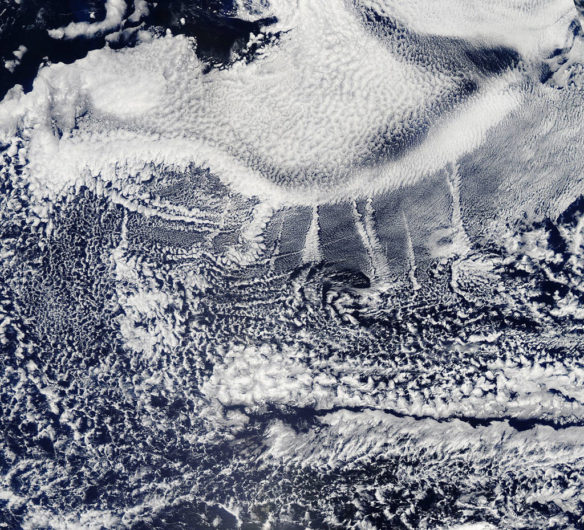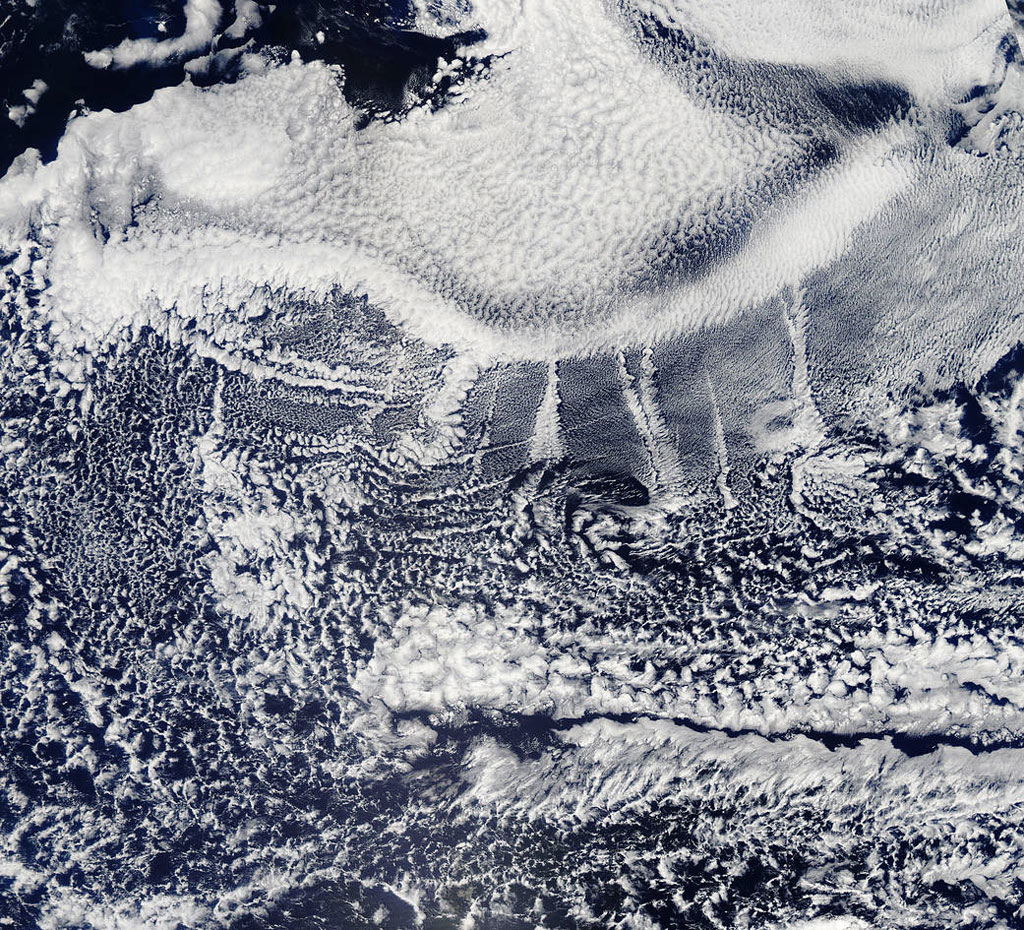
Image Credit: NASA/Lauren Dauphin/Adam Voiland/Bastiaan van Diedenhoven (NASA GISS).
By NASA;
In August 2018, long, narrow clouds stood out against the backdrop of marine clouds blanketing much of the North Pacific Ocean. Known as ship tracks, the distinctive clouds form when water vapor condenses around the tiny particles emitted by ships in their exhaust. Ship tracks typically form in areas where thin, low-lying stratus and cumulus clouds are present.
Some particles generated by ships (especially sulfates) are soluble in water and serve as the seeds around which cloud droplets form. Clouds infused with ship exhaust have more and smaller droplets than unpolluted clouds. As a result, the light hitting the polluted clouds scatters in many directions, making them appear especially bright and thick.
The Moderate Resolution Imaging Spectroradiometer (MODIS) on Aqua captured this natural-color image of several ship tracks extending northward on August 26, 2018. The clouds were located about 1,000 kilometers (600 miles) west of the California-Oregon border. Similar environmental conditions also triggered the formation of ship tracks in this part of the Pacific on August 27 and 28.
An analysis of one year of satellite observations from the Advanced Along Track Scanning Radiometer (AATSR) on the European Space Agency’s Enivisat indicates that very low clouds are most often present off the west coasts of North and South America.
The large number of ships traversing the North Pacific, combined with all of the low clouds, make ship tracks more common here than anywhere else in the world. Roughly two-thirds of the world’s ship tracks are found in the Pacific, according to the study. Other ship track hotspots were in the North Atlantic, off the west coast of southern Africa, and off the west coast of South America.
The research team also detected a clear seasonality in their occurrence: they are most often observed in May, June, and July, and only occasionally present in December, January, and February. Ship traffic is roughly constant throughout the year, so the cycle is mostly due to seasonal changes in the abundance of very low clouds.
Original Article; NASA / GISS (09-04-2018)
At Last, the Shipping Industry Begins Cleaning Up Its Dirty Fuels; Yale e360 (06-28-2018)
By 2020, the global shipping fleet will be required to slash the noxious emissions from thick, sulfur-laden “bunker” fuel, a move that is expected to sharply reduce air pollution and prevent millions of cases of childhood asthma and other respiratory ailments…
Container ships use super-dirty fuel. That needs to change; WIRED (11-09-2017)
About 90 percent of everything we buy will travel on ships like these at some point. And all of these behemoths burn fossil fuel, contributing significantly to the warming atmosphere and shifting climate patterns…
Ship engine emissions adversely affect the health of inhabitants of coastal regions; Science Daily (07-19-2016)
Ship emissions adversely affect the health of inhabitants of coastal regions. This was the main finding of a study on the influence of ship engine emissions on macrophages in the lungs. Since macrophages also play a key role in lung diseases such as COPD, the study is important for understanding the health risks of ship exhausts…
Sea Traffic Pollutes Our Lungs More Than Previously Thought, Science Daily (11-20-2015)
New data show that the air along the coasts is full of hazardous nanoparticles from sea traffic. Almost half of the measured particles stem from sea traffic emissions, while the rest is deemed to be mainly from cars but also industries and natural particles from the sea…
A Satellite’s View of Ship Pollution; NASA (02-07-2013)
Ship exhaust makes oceanic thunderstorms more intense; Science Daily (09-07-2017)
Thunderstorms directly above two of the world’s busiest shipping lanes are significantly more powerful than storms in areas of the ocean where ships don’t travel, according to new research…
Powering ships with plastic in Amsterdam; UNEP (07-09-2018)
Europe Takes First Steps in Electrifying World’s Shipping Fleets; Yale E360 (02-22-2018)
Container ships, tankers, freighters, and cruise liners are a significant source of CO2 emissions and other pollutants. Led by Norway, Europe is beginning to electrify its coastal vessels – but the task of greening the high seas fleet is far more daunting…
“FREIGHTENED – The Real Price of Shipping,” a movie by multi award-winning filmmaker Denis Delestrac-©-2016; (03-31-2016)
90% of the goods we consume in the West are manufactured in far-off lands and brought to us by ship. The cargo shipping industry is a key player in world economy and forms the basis of our very model of modern civilisation; without it, it would be impossible to fulfil the ever-increasing demands of our societies. Yet the functioning and regulations of this business remain largely obscure to many, and its hidden costs affect us all. Due to their size, freight ships no longer fit in traditional city harbours; they have moved out of the public’s eye, behind barriers and check points…
Super-sized ships: How big can they get? Independent (10-21-2014)
Despite the physical limits and risks, ships of more than 450m are anticipated within the next five years…
Breaking Bad on the Beach, NASA / Earth Observatory (09-28-2014)
Tens of thousands of ships ply the world’s oceans, bays, and rivers. But what happens when those ships have become too old or too expensive to operate? In most cases, they end up on the shores of Asia…literally…









